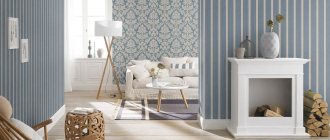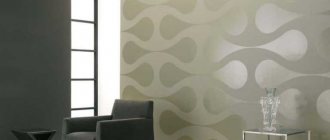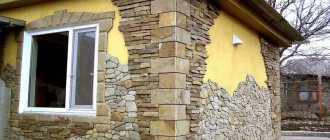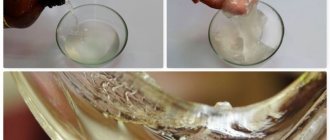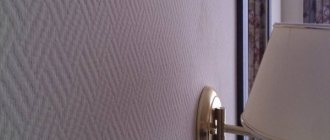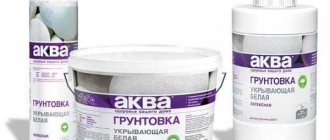Buyer's Guide to Glass Wallpaper
Fiberglass wallpaper is a strong and durable wall covering. They are made from pressed and woven threads of a special type of glass. The method of making wallpaper makes it waterproof.
Despite the fact that it is a fiberglass product, wallpaper allows the walls to “breathe”, thereby maintaining the proper microclimate in the room, which is good for health. Fiberglass wallpaper went on sale more than fifty years ago, but now interest in this material is becoming more frequent and is constantly growing. Their main advantages are:
- Attractive appearance
- Wide range of applications
- Excellent functionality
Recommendations for selection
In order to choose the best glass wallpaper, you need to focus on the following basic parameters:
Density. This criterion directly affects the strength and durability of the canvas. The higher this indicator, the longer the guaranteed service life will be, and the more times the wallpaper will need to be repainted.
Wallpaper chosen for high-quality and long-term finishing must have a density of 100 g/m^2 or more.
Pattern on the canvas. Of course, the choice of textures on fiberglass is quite limited, however, from the available assortment you can choose a texture that is ideal for your apartment.
Whether it will be a “herringbone” or “rice paper” pattern depends only on your preferences, but pay attention to the volume and depth of the relief, this will determine whether the applied pattern will not be lost when the wallpaper is repainted multiple times.
Compound. High-quality wallpaper should contain 70 percent fiberglass and 30 percent special impregnation. Be sure to study this information on the product packaging. If you find a product whose composition does not correspond to these proportions, it is better to refuse to purchase it.
Of course, it is necessary to note both the brand of wallpaper and its manufacturer. Some companies have proven themselves well in the building finishing materials market, so when choosing a good product, you need to take this into account.
A wide selection of high-quality glass wallpaper is demonstrated in Leroy Merlin; the available products are represented by both Russian and foreign brands.
Fiberglass wallpaper will be an excellent alternative to the paper, vinyl, non-woven fabrics and decorative plaster that are already familiar to us. This material is characterized by high strength, durability, moisture resistance, wear resistance, and safety, so it is perfect for finishing any room in an apartment or office.
And the ease of pasting and painting fiberglass sheets will help you quickly make high-quality repairs yourself.
Types and uses of glass wallpaper
Fiberglass wallpaper has increased mechanical strength - it is not damaged by acids or disinfectants. They are easy to wash, which means they will look like new for many years. Resistant to abrasion, impact and scratches, this durable, aesthetic wall decoration can last up to 30 years.
It is worth noting that fiberglass wallpaper can be successfully used when it is necessary to hide imperfections in walls or ceilings. The material effectively covers uneven and cracked plaster. The material is perfect for home kitchens, as well as offices and automotive workshops. Wallpaper provides good visual perception and is easy to install.
In stores you can find a very wide range of product thicknesses, as well as various designs. Such wallpapers are often monochromatic, but you can choose any other texture and convex design
It is very convenient that the proposed forms can be both traditional and modern, which makes it easy to adapt them to your taste, as well as match them to different arrangements. The choice of a specific pattern is for aesthetic reasons, without affecting the quality and method of installation.
Fiberglass wallpaper usually comes in solid colors:
- white
- creamy
- light gray
After installation, they can be painted in any color. The quantity required for painting ranges from 250 to 450 g per square meter depending on the design. The thicker the material, the more paint will be required.
What is glass wallpaper for painting?
When choosing finishing materials for home rooms, you need to think through the entire design so that everything in the new interior looks harmonious and perfect. Remember that the right finish is half the success.
Today, many people prefer modern materials, which are characterized by more advantageous advantages, to standard types of finishing. Recently, glass wallpaper (brands Leroy Merlin and others) have become increasingly popular among the population. This is a modern type of finishing material, which contains substances used in glass production. This, in principle, is evident from the very name of the material.
To produce such an unusual finish, the following substances are used:
- limestone;
- dolomite;
- quartz sand.
At high temperatures these components melt to form yarn. The production technology requires a temperature of +1200C. In this way, light and thin threads are formed from the hot mass. If you press them, you get a fiberglass web. It is used in construction as a fastening material. But glass wallpaper is made in a slightly different way. First, fiber is spun from the formed threads that were noted above. Then they are woven on a special loom, which vaguely resembles a weaving device. The result is rolls of cullet.
Previously, in the 30s of the last century, colored glass was used for the production of glass wallpaper. Somewhat later, a method for synthesizing them from glass and wool was discovered. The resulting products were characterized by excellent quality, which contributed to the popularization of this type of finishing to the current level.
In the interior, this material has a beautiful appearance due to the fact that it can be painted in different colors. We will tell you a little more about how to glue glass wallpaper for painting below.
Designers consider fiberglass wallpaper as the most interesting and practical material, perfect for interior wall decoration. On the walls they look especially presentable.
Some believe that there is only one option for glass wallpaper and they are all similar in appearance. But this is a misconception. Today there are two versions of this product:
- Embossed. The material here has a denser structure, so it will be used correctly for finishing. It is also worth noting that it will be quite difficult or almost impossible to damage it or tear it during gluing. Such glass wallpapers have a wide range of relief patterns.
- Smooth. They are characterized by a lower density, as well as an even texture, which is why they are popularly called “cobwebs”.
If you want to decorate walls or ceilings with such material, you should choose the right not only its type, but also its textured pattern, if any. With the correct gluing and painting technology, your walls and ceiling will have a chic look and will fit perfectly into any interior.
What is important to know when buying glass wallpaper?
If you coat them with acrylic latex or latex emulsion, they are great even in wet areas such as kitchens and bathrooms.
Fiberglass wallpaper is attached to the walls with a special glue - strong and dense. Fiberglass wallpaper is also suitable for gluing ceilings (models are slightly thinner than those for walls). This is especially useful in homes prone to ceiling plaster cracking
When purchasing material, you should pay attention to the fact that the rolls have unusual sizes: 1 25 m or 150 m.
The material is characterized by the fact that it is similar to wallpaper made from fabric, and at the same time devoid of their disadvantages. For example, during their use (even several decades), they can be repainted several times - and the original pattern will still be clearly visible.
Paint for glass wallpaper
Typically, water-based or water-dispersion paint is used to paint such wallpaper. The highest quality compositions can withstand from 1000 to 20,000 washing cycles; acrylic and latex paints wash well. For this reason, they can be used to paint walls with glass wallpaper in corridors and hallways, kitchens, and bathrooms.
Water-based paints are slightly less stable than water-dispersed paints, but their use will not reduce the vapor permeability of walls. For this reason, they are more profitable to use in residential areas.
Special paints for wallpaper are more expensive than regular ones, but before purchasing you should definitely check how compatible they are with glass wallpaper. The thickness of the paint does not matter much, you will just have to apply more or fewer layers.
For a relief surface, matte silk-type paint would be better; for a regular wall, regular matte paint would be suitable. Moreover, when painted, the latter can partially hide the details of the relief.
Construction yardWhat is glass wallpaper/articles/chto-takoe-steklooboi/ Return to the list of articles on products How to buy - Delivery - Returns - Terms of sale of goods - Mobile version - Site map
Features of glass wallpaper:
- High strength and decorativeness;
- Resistance to mechanical damage;
- Naturalness;
- The manufacturing material allows the walls and ceilings to breathe, so they do not affect the air circulation in the room;
- They do not burn, which means that when using them you will protect the premises from the spread of fire, which, of course, significantly increases the safety of the building;
- They are not subject to the destructive power of moisture, temperature changes or various mechanical damage;
- Removing cracks and defects to mask them (moreover, they prevent cracks, like reinforcing mesh);
- You can use them as plasterboard partitions;
- After proper treatment, they become waterproof but breathable;
- Their service life is estimated at 20-30 years;
- They are resistant to damage such as: abrasion, acids, chemicals, water and steam (they can be cleaned with most care products on the market today);
- Can be applied to any surface: drywall, concrete or even wood;
- Non-toxic;
- They are not a breeding ground for germs or mold (parasites do not feed on fiber), so they are suitable for allergy sufferers and people with upper respiratory tract diseases.
As you can see, all the parameters listed above show that glass wallpaper is an excellent alternative to traditional types and will allow you to decorate your interior for many years.
Tools and materials for work
The arsenal for work is simple, which reduces the cost of tools. In addition, even a beginner can work with them. No need to have professional skills. In the process we will need:
- glass wallpaper and glue for them;
- primer, roller and brush;
- rubber roller or plastic spatula;
- metal spatula, mounting knife;
- tape measure, level, pencil;
- container for preparing glue;
- brush for applying glue to the surface;
- if the ceiling is high, then you need a stool, stepladder or sawhorse;
- clean rags and a sponge to remove glue residue;
- protective clothing: goggles, respirator, closed clothing and gloves.
Where can glass wallpaper be used?
They work well in areas that are exposed to moisture as they prevent mildew from growing. As mentioned earlier, thin wallpaper can be glued not only to walls, but also to ceilings.
The material can be used in bathrooms, where they replace tiles (then they are covered with latex paint), and the wall looks as if it is covered with a fabric of a non-banal texture. However, this is not the only way to use them.
The material is so versatile that it will fit well into rooms such as a living room, bedroom, kitchen, hall. In these rooms they will be better than the paper version because they are much more resistant to moisture and damage. Of course, fiberglass wallpaper will look good not only in apartments and private houses.
Suitable for various types of buildings, such as:
- Cinemas;
- Outlets;
- Schools;
- Office rooms;
- Banks;
- Hospitals;
- Medical clinics;
- Hotels;
- Cafe;
- Restaurants;
- Libraries;
- Art galleries and museums.
The material will fit almost anywhere.
Gluing technology
Like any construction and repair process, gluing glass wallpaper is carried out in several stages. It is important to approach each stage with full responsibility and be extremely careful when carrying out all repair operations.
Stage one - preparation
As always, it all starts with dismantling the old finish. Let's look at several types. For example, the most effective way to remove paper wallpaper from walls is to wet it with a sponge. To do this, use a roller or brush. The wallpaper is given a little time to get wet, after which they begin to peel it off (here you can use a regular metal spatula).
If part of the wallpaper has not completely separated from the wall, you cannot leave the wall in this state. An effective way is to iron the remaining wallpaper with a hot iron and wet it again. After this there are usually no problems.
Walls painted with water-based paint are simply washed with a rag or sponge. But oil paint cannot be removed this way. It is often removed with sandpaper, but this is time-consuming and difficult, so there is a mechanical method. To do this, a special metal brush is inserted into the drill; with its help, the paint can be removed in a day. It is better to buy a special remover for oil paints. After its application, the paint softens and is removed with a spatula. In the worst case, you will have to put notches on the walls and putty them before gluing.
So, the wall decoration has been eliminated. Now, for better adhesion between the materials, it is primed. After drying, the wall surface is leveled and small defects are repaired at the same time. Fiberglass wallpaper itself, with its dense structure, can cover both small differences in plane and minor defects. We offer articles on leveling walls: leveling with plasterboard, plastering on beacons. The last operation in the preparatory stage is priming the prepared wall.
Stage two - prepare the glue
We have already said that every operation in this difficult matter is very important. This also applies to the preparation of the adhesive composition, because the long-term operation of the wallpaper glued to the walls depends on its proper preparation. For glass wallpaper, for example, you cannot use glue for paper analogues. This is the biggest mistake that beginners sometimes make in this business.
The textured surface, which is also very dense, weighs much more than an ordinary sheet of paper. But glue for paper wallpaper is not designed for such weight, it simply will not hold the material on the wall, there will not be enough adhesion force.
Typically, manufacturing companies offer their own adhesive suitable for their material. Most often, Oscar glue is used for glass wallpaper with a colored pigment, which shows uniform application. There is also a universal frost-resistant adhesive for glass wallpaper: Pufas, Security GK 10, Kleo Ultra and others. This composition is stirred with ordinary water to a certain consistency. But we won’t delve into all the details of preparing the glue; instructions are on the package.
There are glass wallpapers for which you do not need to buy glue for gluing. For example, Vitrulan Aqua Plus already has an adhesive layer; to stick it, just moisten it with plain water.
Stage three - glue wallpaper on the wall
The process is practically no different from the standard procedure. Here it is also necessary to avoid drafts, carry out all work at room temperature and try to prevent direct sunlight from falling on the walls.
Let us note only a few nuances.
- An important point is equipment. Glass fibers will crumble and particles may cause skin irritation. To avoid this, we glue the glass wallpaper while wearing long sleeves and putting gloves on our hands.
- Glass wallpaper has two sides: the back and the front. In a roll, the front side is on the inside, the back side is always marked with a blue or gray stripe.
Now we glue the wallpaper. First, strips of material are cut with a small allowance, which compensates for the alignment of the pattern. Lay the strips end to end. It is important here to connect them accurately without cracks or gaps. By the way, the glue must be applied to the surface of the wall, and not to the material itself. A roller is usually used for this.
Each strip is rolled with a clean roller or a special spatula to remove remaining air and glue from under the material. The joints must be cleaned of glue with a clean cloth or sponge. Using the same technology, you can glue glass wallpaper to the ceiling. The stage of pasting the walls is shown in the video:
Stage four - painting
You can paint fiberglass wallpaper only after it has dried thoroughly. Therefore, you will have to wait two days. Due to the porous structure of the material, the paint is quickly absorbed. To reduce its consumption, the finishing surface must be treated with a primer (it can be made from wallpaper glue). This is a thick aqueous solution.
Consumption of painting material is 500 g per square meter of surface. Painting of glass wallpaper is carried out in two layers, the time between which is twelve hours.
Until recently, this finishing material was used only in public and office spaces. But with an increase in quality characteristics (let's give credit to the manufacturers!), fiberglass wallpaper can now be used to decorate walls in living rooms.
How to glue glass wallpaper?
Glass wallpaper is attached to the wall and ceiling with glue. However, here the glue is applied not to the material itself, but to the wall - only then will they be able to be securely attached. It is very important to choose the right glue for heavy wallpaper.
The glue is applied to the surface of the wall or ceiling with a brush or paint roller. The resulting layer should be uniform, and the wallpaper applied to it should not have gaps between individual pieces.
During installation, fiberglass may irritate hands, other parts of the skin, and eyes. Therefore, it is necessary to use gloves, safety glasses and a dust mask while working.
Step-by-step instructions for gluing glass wallpaper
1. Preparing the base.
At the initial stages of work, the most important thing is to remove from the walls the remains of other coatings, for example, parts of paper wallpaper, as well as elements extending from the base.
Finished walls or ceilings must be smooth, clean and dry. How to achieve this effect? Any unevenness, that is, first of all, holes in the walls, must be sealed with putty (such work concerns cavities larger than 2 mm).
Wash the painted surfaces well with a 5% aqueous solution of ammonia or soda. Then they should be washed thoroughly with clean water. Later it is good to prime the absorbent base. This is done either with glue diluted with water or with a special primer. It is also worth knowing that a lot depends on the substrate under fiberglass wallpaper.
Therefore, it must be coated with substances that will have the appropriate properties (for example, the metal must be coated with anti-corrosion primer paint).
The plasterboard substrate only needs to be cleaned of dust and vacuumed (no need to prime). The uniformly bleached cement-lime base should be primed (preferably with a solution of flax varnish and varnish gasoline).
After normal priming (with water preparation), work with wallpaper can begin in 2-4 hours, and after varnishing - after 3 days.
Once all this prep work has been completed, it is worth carrying out an adhesion test to ensure that the substrate is prepared correctly.
2. Trimming wallpaper.
Rolls are usually 100 cm wide and 50, less often 25 meters long. Therefore, they should be cut to the required size. This should be done with a sharp knife or scissors.
It is recommended to first cut the strips so that there is a margin of about 10 cm (later this will help to level the wallpaper).
3. Gluing wallpaper.
Firstly, the glue itself. Due to the fact that fiberglass is a rather specific material, ordinary wallpaper glue is not enough to attach it to the wall. In this case, you need to use glue designed for heavy wallpaper.
When choosing it, you should pay attention to several parameters, including:
•peel strength;
•drying time: good glue should dry in at least 1 hour, but no more than 3 hours;
•vapor permeability (the adhesive coating must have a permeability of 40 g/m2).
As for the required amount of glue, it is usually indicated by the manufacturer of the specific wallpaper. Usually this is 0.2-0.4 kg per m2. The selected adhesive is applied (with a roller or brush) to the base along the entire intended width of the strip.
Care must be taken here to avoid lumps, so that when successive strips of wallpaper are applied, previous excess adhesive does not start to drip between the individual strips. It is best to apply glue from the ceiling down (because this is how the wallpaper will stick later).
So, the next step is to wallpaper the wall. The strip glued to the base is immediately pressed and smoothed - with a plastic spatula or rubber roller.
Fiberglass wallpaper, both smooth and textured, should dry for about 24 hours after gluing to the wall. After this time, it is sometimes recommended to apply another layer of glue to its surface.
This will limit the flow of moisture, and it will prime the wallpaper well - ready for applying paint.
4. Painting glass wallpaper.
This work is best done with a fur brush, which will allow you to thoroughly cover the patterns. A thin layer of paint is applied to the wallpaper and then painted a second time. It's a good idea to use latex paint.
Important tip:
If you want to paint fiberglass wallpaper in rich colors, paint it white first and then paint it in the desired shade.
Finally, it is worth adding that the place for placing fiberglass wallpaper should be well thought out, since they are difficult to remove.
How to choose the right glass wallpaper
There are some practical tips from professionals to make the right choice of glass wallpaper. They are as follows:
- The main indicator of quality and reliability is the density of the fabric. To save money, some dishonest manufacturers add starch impregnation to increase the density of fiberglass wallpaper. At first glance, this is not visible, since the wallpaper is in rolls. This can be determined already at the pasting stage. Therefore, it is better to give preference to proven brands.
- The texture is subject to artificial change by fluffing the threads. After this, it becomes more voluminous. This can only be detected when gluing glass wallpaper, while expelling air from under the material.
- To determine the quality and not choose bad fiberglass wallpaper, you can take a sample of the product and check its characteristics: touch it, examine it.
- What is the best way to paint glass wallpaper? Since the walls will be exposed to dirt and dust, it is better to choose latex glossy and semi-gloss paint materials. If the room is damp and has high traffic, then the paint must also withstand these factors.
- To decorate the ceiling, it is better to buy cobwebs. It is smooth and has no pattern or texture on the surface. This will eliminate the need to join the pattern, and thanks to the reinforcing properties, the ceiling will be strengthened and leveled. Second grade glass wallpaper is suitable for these purposes.
- Products can be selected for any room. Fiberglass wallpaper is strong, durable, environmentally friendly and resistant to various influences. Therefore, they can be safely used for corridors, kitchens, and children's rooms.
These were the main points to consider when purchasing glass wallpaper. By adhering to them, you can rest assured that you will purchase high-quality material that will last for decades. And there shouldn’t be any problems with gluing it to the wall either. Although their price is higher than that of ordinary wallpaper, they are clearly superior in their characteristics and properties. All that remains is to complete all the preparations and carry out the work of gluing the canvases. It's better to do it yourself to save money.
Pros and cons of glass wallpaper
Like any other material, this type of wallpaper has its drawbacks.
The disadvantages of glass wallpaper include the following:
- The material is made of fine fiberglass and although they are not dangerous, they should be handled with care;
- During processing (for example, cutting), dust may escape from the wallpaper, which should not be in prolonged contact with the skin, the respiratory tract must also be protected from it (to avoid irritation): therefore it is necessary to use gloves, masks and safety glasses;
- They require quite painstaking surface preparation;
- They are not easy to remove from the walls.
If we talk about the advantages of glass wallpaper, there are really many of them:
- Durability (wallpaper service life is estimated to be up to 30 years);
- Resistance to aging processes;
- Non-toxic;
- High mechanical resistance (to abrasion, scratches and impacts);
- Possibility of painting several times (while maintaining the visibility of the original design);
- Low water absorption (meaning very little paint is usually used when painting);
- Masking surface irregularities;
- Effective coating of cracks on the surface of walls or ceilings;
- Resistance to acids, disinfectants and water (which means that they can be washed and cleaned with chemicals without fear of damaging their technical and aesthetic properties);
- No contact with fungi and microorganisms;
- Freedom of installation on various surfaces: concrete, drywall or wood;
- Non-flammability (which is especially important in public buildings, and this characteristic is due to the properties of the material from which the wallpaper is made);
- Highly aesthetic finishing (the final effect is such that no traces of seams are visible, which also makes the replacement of damaged fragments almost invisible);
- They can be used in hospitals because, due to their properties (for example, the ability to wash and wipe), fiberglass wallpaper helps maintain the sterility of rooms.
As you can see, the list of advantages of the wallpapers described here is much longer than their disadvantages. This clearly shows that using fiberglass wallpaper brings many tangible benefits. Proper preparation for their installation and a protective suit will minimize most of the above disadvantages.
Composition and types
Don't think that there is an inaccuracy in the name of the new wallpaper. Everything is accurate: wallpaper is made from glass threads held together with a stabilizing impregnation.
“Spiderweb” (painting fiberglass)
The web is obtained by pressing fiberglass. This is a loose, relatively loose material that is used for reinforcement and leveling of surfaces (not for finishing).
Fiberglass is woven on special looms to produce fabric that is used as a finishing material. At the same time, the texture of the resulting fiberglass can be very diverse. Traditional weaving machines produce fabrics with simple textures: herringbone, diamond, parquet, matting, etc. On jacquard looms, which are controlled by a computer, textures of any degree of complexity are obtained, for example, company logos, hieroglyphs, imitation crocodile skin, and floral patterns.
The fabric made in this way turns out to be too soft - it does not hold its shape and is unsuitable for use as a finishing material. Therefore, it is impregnated with a composition that includes modified starch - this gives the wallpaper greater density and rigidity. The density of the wallpaper depends on the amount of impregnation: for example, for glass wallpaper, a density of 100 g/sq.m. is considered normal. m, and the web is produced less dense - 35-50 g/sq. m. When gluing wallpaper, the impregnation dissolves and mixes with wallpaper glue, which ensures reliable fastening of the canvas to the surface.
Advantages
Consider a wallpaper option that is highly durable. Experts also differentiate by design in their works.
- Environmentally friendly material.
- Long service life.
- UV resistance.
- Water resistance.
- Can be used in rooms with a lot of moisture.
- Lets air through.
- Dust does not accumulate on them.
- Painting glass wallpaper is not difficult.
- Can be used in the design of a children's room, as the materials are non-allergenic.
- Fire resistant.
If there is a fire in the building, no toxic impurities are released. Experts recommend using glass wallpaper in corridors.
Flaws
They are not that significant, but you need to get acquainted with them before purchasing. It is advisable to buy from trusted stores.
Buying wallpaper that does not meet the requirements may result in unpleasant situations in the future.
- Wallpaper for the ceiling that will help hide unevenness: recommendations for choosing
- Interior print on canvas
- Vinyl wallpaper in the interior - 120 photos of amazing design.
- Dismantling them is not so easy.
- The cost is high.
- Poor quality wallpaper may lose its texture during painting.
- During installation work, protective equipment should be used.
- To apply pasting, you need to level the surface of the wall.
Selecting the best glass wallpaper
Before purchasing wallpaper, you need to know about some pitfalls:
- Some manufacturers can impregnate the material with starch to increase density. It is quite difficult to determine this right away. This will become clear only when applying glue for glass wallpaper, the starch will begin to dissolve. Therefore, it is highly recommended to buy products from well-known brands.
- The texture can also be artificially changed by fluffing the threads. As a result, the product acquires greater volume. This can only be detected when smoothing the wallpaper on the surface to be pasted.
Photos of glass wallpaper of various types in rooms with different interiors will help you make your choice.
Advantages and disadvantages of fiberglass wallpaper
Pasting walls with glass wallpaper has its pros and cons. The first are summarized in the table below.
| № | Advantages | Description |
| 1 | repeated painting | canvases can be painted up to 20 times with special compounds (the original texture is preserved), which increases the strength of the created decorative coating |
| 2 | non-flammability | when heated, the material does not ignite, toxic substances are also not released, which increases the degree of fire safety and allows use near fire sources (for example, in the kitchen) |
| 3 | moisture resistance | this allows you to wallpaper rooms with a high moisture content (bathrooms, toilets) with such wallpaper. |
| 4 | air permeability | helps maintain the natural microclimate indoors |
Comparison of glass wallpaper with a vinyl analogue in terms of strength
The disadvantages include the following factors:
- relatively high cost compared to other classic types of wallpaper, much smaller range;
- there is a possibility of difficulties arising when dismantling the created finishing coating;
- low-quality products are fragile and can break right in your hands;
- it is necessary to prepare the surface of the base almost perfectly in order to glue the strips;
- When working with fiberglass, you must wear protective clothing because it is scratchy.
The distribution and scope of glass wallpaper are significantly influenced by advantages and disadvantages. The high price acts as a deterrent, but if you look into it in detail, many undeniable advantages lead to saving money.
Advantages of glass wallpaper
The following can be considered positive characteristics:
- Strength. At the moment, the products are considered the most durable finishing material for walls. They do not tear, are not subject to deformation, and are resistant to mechanical damage. In addition, they are not afraid of wet cleaning, even with the use of chemical compounds. This characteristic allows you to glue glass wallpaper in the bathroom.
- Improves the microclimate of the room. The structure of the product is similar to knitting, consisting of loops, which allows moist air to pass freely between them. Due to this, the wallpaper does not have static electricity, which results in less dust being attracted.
- Safety for the environment, environmental friendliness. Glass fiber cannot harm humans and does not create a favorable environment for the proliferation of dangerous microorganisms. In addition, glass wallpaper prevents the formation of mold and mildew.
- Resistance to mechanical damage. Fiberglass fabric is not subject to deformation when subjected to physical impact.
- Possibility of partial restoration. Replacing any section of the finish will not be difficult, since this material fits perfectly together with any cut.
- Fire resistance. The glass that is part of the wallpaper protects it from burning, and no harmful substances are released upon contact with fire.
- Easy to paste. No special skills are required for the job. You can easily do the pasting yourself.
- Durability. Proper care and proper use ensure the wallpaper has a service life of up to thirty years.
- A huge selection of materials in color, texture, pattern.
Special assembly composition
Fiberglass material must be glued only with special glue. It is produced together with wallpaper or there is a universal OSKAR adhesive composition.
It consists of vinyl polymer and special binder additives. Glue is odorless and colorless. When completely dry it becomes transparent. Available in two types:
- Dry powder . Dilute it with water at room temperature. Swells within 10 minutes. Apply only to the surface to be pasted. The powder can be stored for up to 7 years. Does not respond to temperature changes over a wide range.
- Ready water dispersion composition . It contains ingredients that prevent the formation of mold and the development of bacteria. Sold in containers of different sizes. Must be stirred before use. Apply to any surface: brick, concrete, metal, wood, plaster, paper.
Ready-made solutions can be used as a preliminary surface primer for dust removal and better adhesion of materials.
